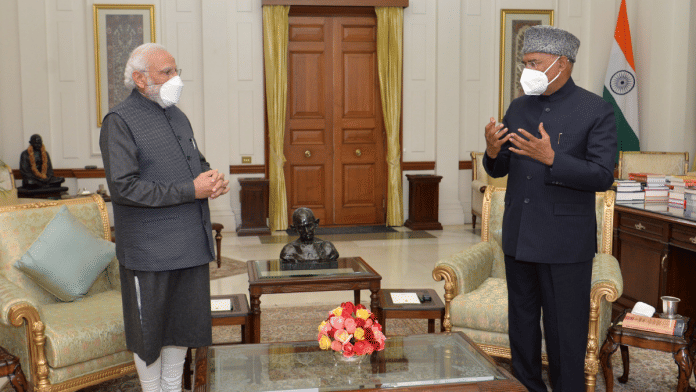New Delhi: The BJP may have won in four out of the five states that went to the polls this February/March, for which the results were declared Thursday, but it still doesn’t have the numbers it needs in the electoral college (which comprises MPs and MLAs) to ensure the victory of its candidate in the Presidential election later this year. In fact, it is a little worse off than it was in July last year.
The BJP-led National Democratic Alliance (NDA) government is falling short by about 1.2 per cent of the total votes it needs for its candidate to sail through. The tenure of current President Ram Nath Kovind ends on 24 July this year.
However, BJP leaders may not be losing sleep over this, since they will likely be able to bank on the likes of Andhra Pradesh Chief Minister Jagan Mohan Reddy’s YSR Congress Party and Odisha CM Naveen Patnaik’s Biju Janata Dal to secure a majority in the college.
NDA shortfall mostly due to UP
In a report published in July last year, ThePrint had estimated that the NDA was just 0.05 per cent votes below the majority mark for the Presidential poll. But now, it is a little worse off.
Factoring in all the political developments since July 2021, including the results of the 2022 legislative assembly polls, the NDA is now at least 1.2 per cent away from 50 per cent vote-share in the Presidential poll.
This fall in the NDA vote-share can largely be attributed to the BJP’s fall in numbers in the Uttar Pradesh and Uttarakhand legislative assembly elections.
In the Presidential poll, an MP, whether from the Lok Sabha or Rajya Sabha, carries a vote-value of 708, which is based on a pre-decided formula.
The vote value for each MLA varies, depending on the state’s population (based on the 1971 Census) and its number of assembly seats. UP’s MLAs carry the highest value among all the states: 208. Four MLAs from the state can nullify an MP’s vote. But this is where the NDA has gone down.
In the 2017 UP elections, the BJP and its ally Apna Dal (Sonelal) had won 312 and 11 constituencies respectively, adding up to a total of 323 assembly seats.
By July 2021, this strength had come down to 315 owing to some vacancies. In the 2022 elections, the BJP won 255 seats and Apna Dal (S) 12. Adding to this, six MLAs from another ally, Nirbal Indian Shoshit Hamara Aam Dal (NISHAD), the NDA now has 273 assembly seats in the state.
In other words, within eight months, the NDA has faced a loss of 48 MLAs in Uttar Pradesh, amounting to about 0.9 per cent of the total vote-share in the Presidential poll.
As for the other states that went to polls this year, the BJP’s seats in Uttarakhand came down to 47, from 56 in July 2021. In Manipur, the NDA was reduced to 32 MLAs from 36 MLAs in July 2021, unless allies who contested the elections separately from the BJP decide to join hands again. In Goa, the NDA has come down from 28 MLAs to just 20, with outside support from its old ally, the Maharashtrawadi Gomantak, which has two MLAs in the state assembly. In Punjab, there was no change and the BJP has two seats now as it did then.
Each of these states, though, have modest vote-values for each MLA. A Punjab MLA has a vote-value of 118, Uttarakhand 64, Goa 20, and Manipur 18.
Overall, the NDA currently is roughly 13,000 votes away from touching the majority mark in the Presidential poll. The total vote-value at stake is about 1,093,347, of which the NDA has 48.8 per cent.
A little help from ‘friends’ could do the trick
Some regional parties have a significant stake in the electoral college. The most prominent among these are Mamata Banerjee’s Trinamool Congress, Arvind Kejriwal’s Aam Aadmi Party, K. Chandrashekar Rao’s Telangana Rashtra Samithi, Jagan Mohan Reddy’s YSR Congress Party (YSRCP) and Naveen Patnaik’s Biju Janata Dal (BJD).
With Punjab in its kitty, AAP has 1 per cent, Trinamool Congress has 3.05 per cent, YSRCP has 4 per cent, TRS has 2.2 per cent, and BJD has about 3 per cent.
Of these parties, some are decidedly unfriendly to the BJP. Mamata Banerjee is a strong opponent of the BJP and Arvind Kejriwal isn’t likely to support it either. KCR, too, seems to have made up his mind that he is no friend of the BJP.
This leaves the NDA with Jagan Reddy’s YSRCP and Naveen Patnaik’s BJD as possible friends. Both these parties have maintained relatively friendly relations with the BJP-led Centre. Both parties backed the NDA’s Citizenship (Amendment) Act as well as the scrapping of Article 370 in Jammu and Kashmir in Parliament.
If either YSRCP or BJD come to the rescue, the NDA could get the votes it needs to elect its Presidential candidate.
(Edited by Asavari Singh)
Also Read: How the President of India is elected






